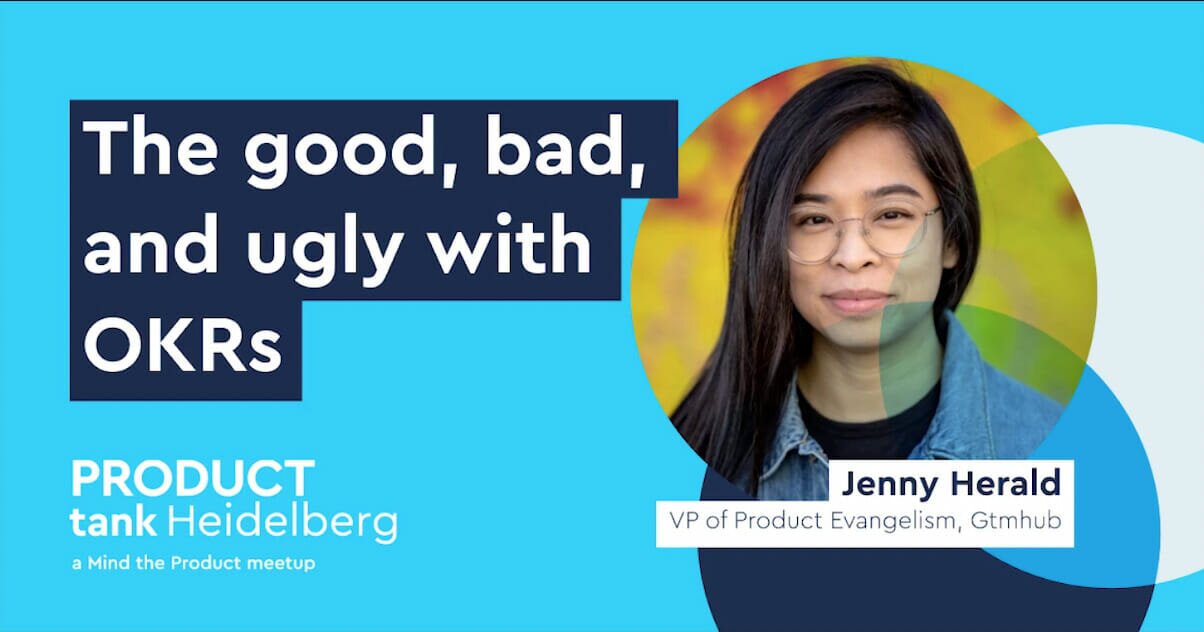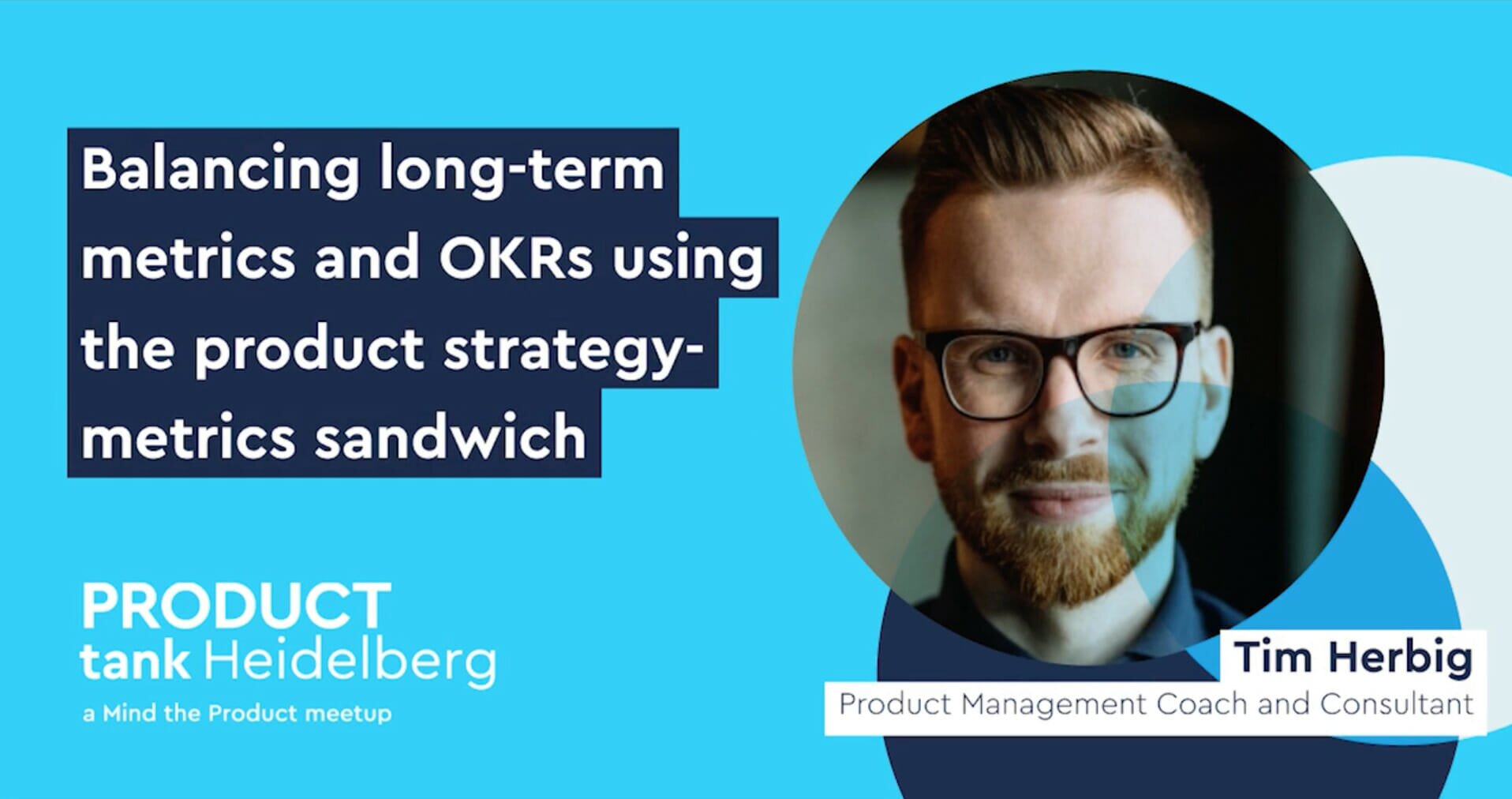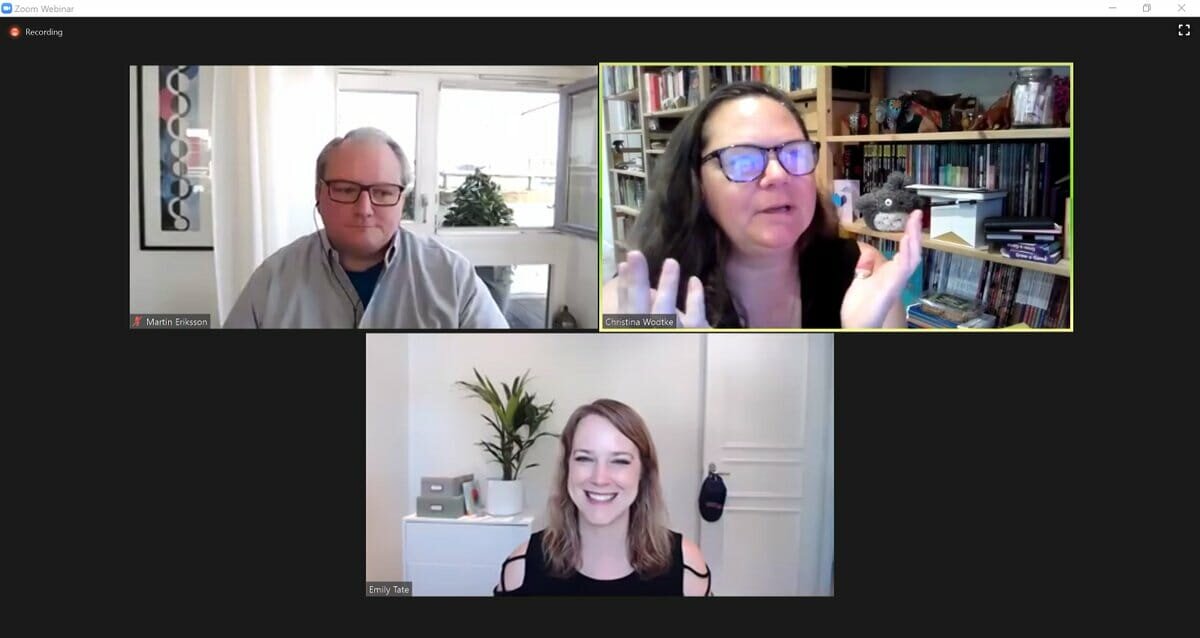The popular Objectives and Key Results framework (OKRs) can be a powerful tool, provided it's understood and used correctly. With this in mind, we recently undertook a survey to understand how companies are using OKRs in the wild.
Our survey was run in collaboration with Timm Richter, CEO of NEO Culture and former chief product officer at XING, and Arne Kittler, VP Product at XING and co-curator of MTP Engage Hamburg. Read on for the results and a recording of the #mtpcon Digital panel discussing them!
The results indicate the use of the framework is still relatively undeveloped in the businesses surveyed, although attitudes towards them are largely positive and there are many challenges in their implementation. For a top-line view of the survey results, you can read our overview while this extended analysis of the survey’s trends will help you understand the benefits, effects, challenges of OKRs, and how to get the most from the process of setting them.
We’ve split our 160 survey participants into five groups:
- Executives (26% of participants) whose job level is executive management
- OKR veterans (22%) who have used OKRs for more than two years
- Impact reporters (21%) who state that they have seen significant performance improvements from using OKRs
- Big companies (30%) participants working in organisations of over 1,000 staff
- Small companies (24%) working in businesses of up to 50 staff
How do Companies Implement OKRs?
Most companies set their OKRs quarterly and find it hard to limit the number of objectives and key results
Cadence
Our survey shows that most companies (73%) set OKRs quarterly and that most companies (71%) also take up to two weeks to set and agree upon them. Impact reporters take longer to set OKRs – 38% of them say that their company takes three weeks or more than two weeks.
In How to find the right OKR cadence, an interview published on Perdoo, OKRs Coach Felipe Castro explains that, as our survey results suggest, the most common cadence involves annual OKRs at the company level and quarterly OKRs for teams. Says Felipe: "If you are starting with OKR, I recommend using a quarterly tactical cadence with a mid-quarter review. That will enable you to learn and adapt your model." In the same article, Felipe says that cadence isn't set in stone – it's okay to break from the norm. "Organizations can customize the cadences for their needs. For example, Spotify developed their version of OKR called Spotify Rhythm which uses a strategic cadence of six months and a tactical cadence of six weeks."
Number of Objectives and Key Results
According to acknowledged authorities on OKRs, when setting objectives, it’s important to limit their number. John Doerr in his book Measure What Matters quotes the father of OKRs, Andy Grove, as saying, “keep the number of objectives small”. In her article, The Art of OKRs, Christina Wodtke says you should set them only for things that are absolutely critical to your company’s strategic vision and maintains that just one can be ideal. She says: "if you have one OKR set, you only have four things to remember and they are nicely chunked into a single big idea". During her Mind the Product AMA session, Encouraging Autonomy and Writing Awesome OKRs, she talks about this further, saying: "Life is so full of distractions that we often forget to do this really critical strategic thing so OKRs are a way of making important things urgent by saying we’re doing them now and we’re doing them in this timeframe. But there’s also a bunch of other things you still have to do."
Our results show that limiting objectives and key results to fewer than 3 can be a challenge for some:
- 38% of teams have more than 3 objectives
- Only 8% report to have 1 objective per team
- Over a third have more than 3 key results per objective
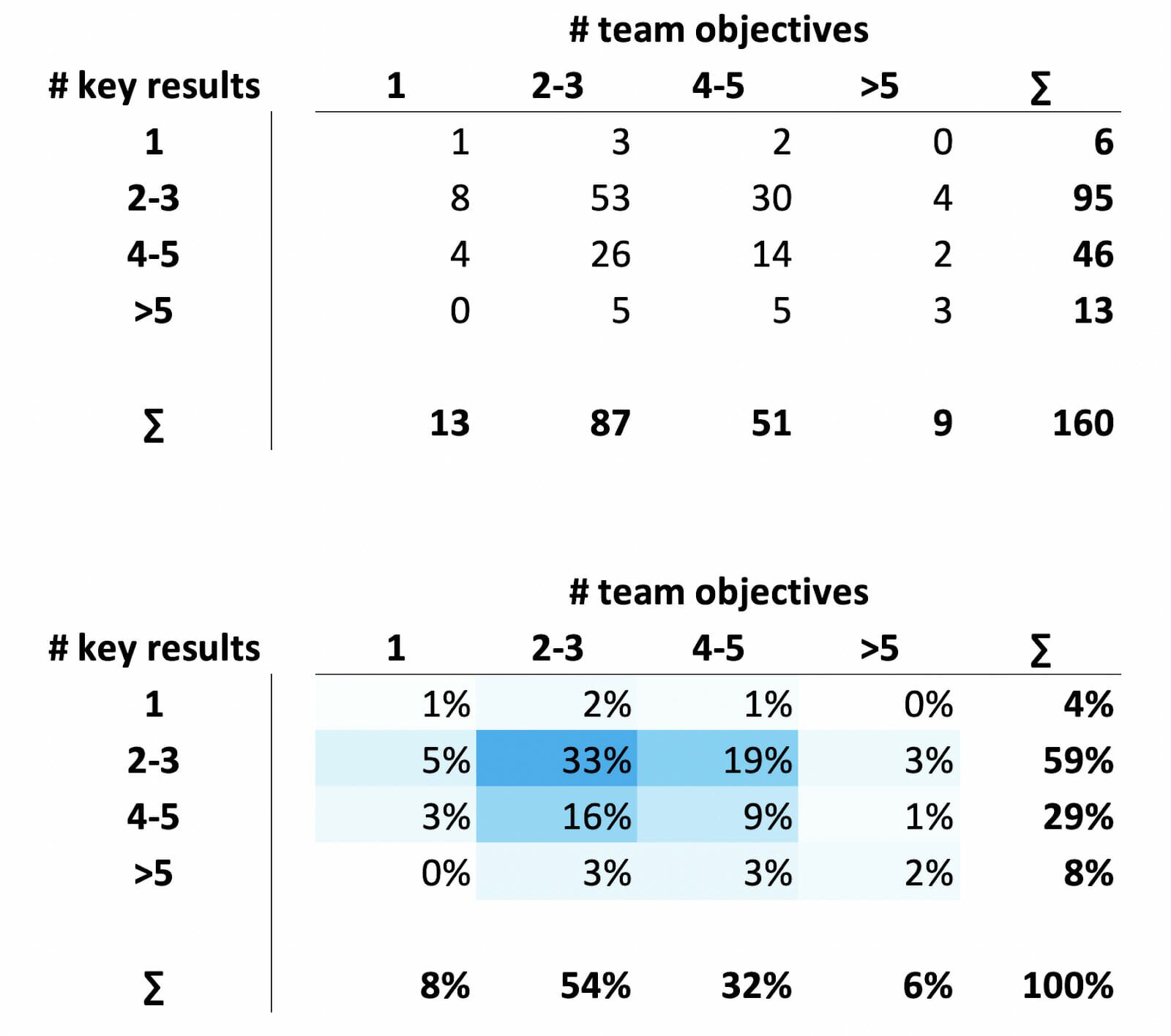
If you feel overloaded with OKRs within your company, or if you have more than three objectives or key results per objective, it can be worth considering how you might drive more focus.
"I would always recommend working towards fewer objectives and key results where possible," says Timm. "Ask questions like 'what would happen if we took one out?' and 'if we take this one out for a cycle, will that really hurt us?'. This can be a helpful way to push for less where the normal tendency is to have more."
In The Art of OKRs, Christina suggests that sequencing can be a good way to narrow down your objectives. She says: "Are there things you could do first that would make another effort more effective? Should you improve the customer experience before spending a bundle on advertising?" If that doesn’t work, Christina recommends simply narrowing them down to as few as possible and ranking them by importance.
Tools
Over half of our participants (55%) told us which tool they use for OKRs and of those, 42% report that their company takes a low-tech approach to prepare, share and track OKRs. Most use general-purpose tools, including:
- Google Docs (16%)
- Excel & Co (16%)
- Confluence (7%)
- Jira (3%)
Says Timm: "Quite often when teams introduce a new process, they focus on the tools they might use, rather than getting the basics of the process right or concentrating on the content, so I found it refreshing to see that many companies take a low-tech approach to OKRs. I think this is also reassuring for people who are just starting out because the reality is that you don't have to invest in special software to do OKRs well."
Of course, there are special tools if you're in the market for one and they might be helpful should you want to get a head start. Our survey participants mentioned the following:
Team OKRs versus Individuals OKRs
The majority of companies opt for team OKRs and don't link results to individual performance
OKRs can be implemented at a company, team, and individual level, so which combination does our survey suggest is the preferred or even the most successful approach?
The preferred approach is clear – 78% of participants say that their company uses team OKRs, but not individual ones. And 69% of the participants report that they start an OKRs cycle with company-wide OKRs.
Those who more often choose to use individual OKRs are:
- Impact reporters, 39% (instead of 22% on average)
- Those in small companies (35%)
- OKR veterans (30%)
This might indicate that individual OKRs are more likely to be implemented as companies gain more OKRs experience, something Perdoo CEO, Henrik-Jan van der Pol seems to support. In his article The pros and cons of individual OKRs, he suggests that sticking to team OKRs is a sensible step for those just starting out. "For companies new to OKR, it takes a while to get into a flow with the framework, usually a couple of quarters. With company and team OKRs in place, adding individual OKR adds an extra level of complexity and increases the workload for managing and updating them."
In addition, when asked if their OKRs are linked to individual performance, 79% of participants said no, something Rick Klau, Senior Operating Partner, Google Ventures, would support. In his blog post, How Google sets Goals, Rick says: "OKRs are about the company’s goals and how each employee contributes to those goals. Performance evaluations – which are entirely about evaluating how an employee performed in a given period – should be independent from their OKRs."
Top-Down or Bottom-Up?
The approach to OKRs implementation in most companies is top-down oriented and conflicts around OKRs are typically handled by top management
It's a common misconception that OKRs take a bottom-up approach. While it would be nice to think OKRs always harvest the intelligence of the crowd, as John Doerr writes in Measure What Matters, they are "bottom-up or sideways“ – but never purely bottom-up. Our survey results suggest that bottom-up is, in fact, rarely the approach taken.
- 77% of companies start with annual goals for the company (with the exception of small companies at only 62%)
- 69% of participants report that an OKRs cycle begins with top management setting the company OKRs first
- Over 54% of companies cascade OKRs from top to bottom first. Only 12% do it the other way round
- 62% of participants say the CEO or top tier of management introduced OKRs to their company
Resolving OKR Conflict
Anyone who's been through the OKRs process will know that when multiple teams define their OKRs in parallel, it's not uncommon for them to notice that they have different perspectives and priorities. As a result, conflict can occur.
In Timm's opinion, people should welcome this clash of perspectives. "A regular OKR process facilitates a lot of discussion and exchange within a company and conflict paints a more complete picture of the situation teams and top management are facing," he says. "If there is no conflict, you are missing a perspective."
Indeed, one function of the OKRs process is to surface and resolve those kinds of conflict and we were interested to learn how this is typically managed.
In more than 52% of the companies, when conflict occurs, top and middle management get involved, and this is especially the case when the conflict is considered to be 'tough'. In these situations, teams aren't left to resolve conflict themselves – 80% of the participants say that middle or top management steps in.
Says Arne: “Product managers don’t need to shy away from escalating decisions which they cannot resolve among peers – the alignments around OKRs can help to make this process transparent and more natural.”
While our results suggest that OKRs are generally top down, Timm suggests that because of discussion driven by the OKRs process, the top-down bottom-up balance is somewhat addressed.
"What I have seen is that while management is typically expected to set goals and solve conflicts, their opinion forming is strongly influenced through the OKRs process and you'll find that over many OKRs cycles a shared understanding of priorities is developed through top-down and bottom-up interactions," he says.
The impact reporters, he adds, may serve as a case in point. They let the teams work out OKRs on their own, only stepping in when teams get stuck. In particular, they report more often having:
- Bilateral team alignment meetings: 65% of impact reporters say they have them compared to 52% on average. This helps to create a shared understanding
- Meetings with all teams: 54% impact reporters say they have them, but only 45% of all participants have them. Again, this facilitates fruitful discussions
- Conflict solving among teams: 62% impact reporters state that teams sort out conflicts without middle managers or top management
- Top-management involvement for critical issues: When conflicts become difficult, 62% of impact reporters say that top management doesn't hesitate to step in. In total, only 54% of participants say the same
Insights Beyond Implementation
Generally, OKRs are viewed positively and are used mainly as a tool for company-wide decision making
When presented with positive and negative items describing the OKRs process, participants chose more positive items (22% on average) than negative ones (10% on average). For the top 10 list of items, see the table below.
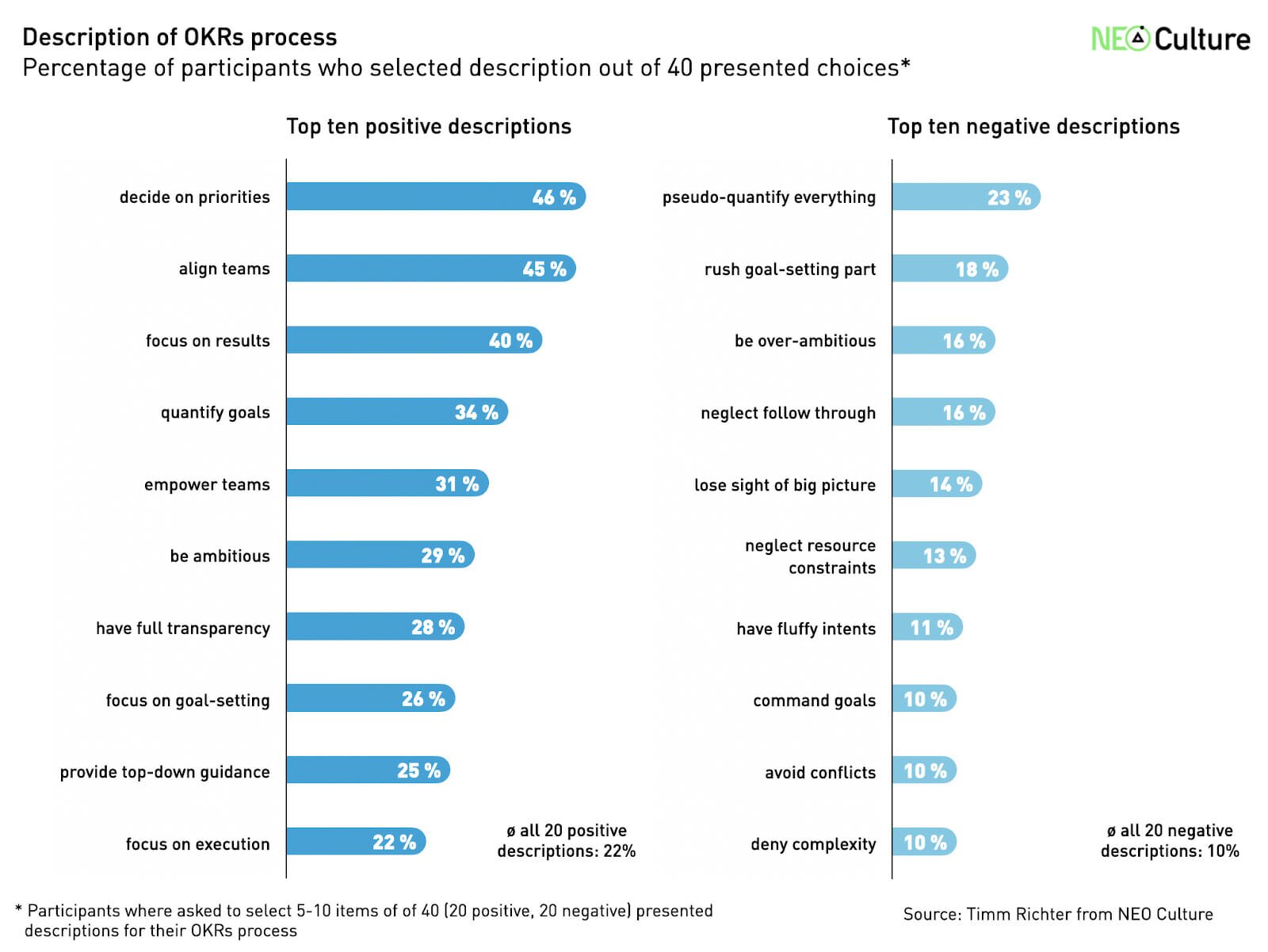
Top positive items:
- Deciding on priorities (46%)
- Aligning teams (45%)
- Focus on results (40%)
Top negative items:
- Pseudo-quantify everything (23%)
- Rush goal-setting part (18%)
- Neglect follow-through (16%)
- Be over-ambitious ( 16%)
"The top three positive items are not surprising," says Timm. "The OKRs process can help us to settle conflicts, such as deciding on a company direction and aligning all teams accordingly. In terms of priorities, the more that conflicting messages are resolved, the more teams can focus on finding ways to realise those priorities."
The results also show variations in the way our different groups of participants see the OKRs process:
- For small companies, OKRs are more about getting a sense of intent in order to enable ambitious goal setting
- Impact reporters state more often that OKRs are a way to empower teams
- More executives than the overall participants find that creating transparency is a relevant aspect of the OKRs process
Transparency is important
Product people often say that OKRs help to increase transparency within an organisation and even attribute using OKRs to wanting to achieve more transparency. Our results support this.
In 68% of all companies, everybody can see all OKRs. In small companies this number is 86%, in large companies, it's 51% while 48% of all participants say the main benefit of using OKRs is increased transparency across the organisation.
The main challenge is in setting good objectives and key results
We asked our survey participants to score six typical challenges of OKRs on a scale of six, with 1 indicating “no challenge at all” and 6 indicating “a great challenge. The table below shows what they find most challenging.
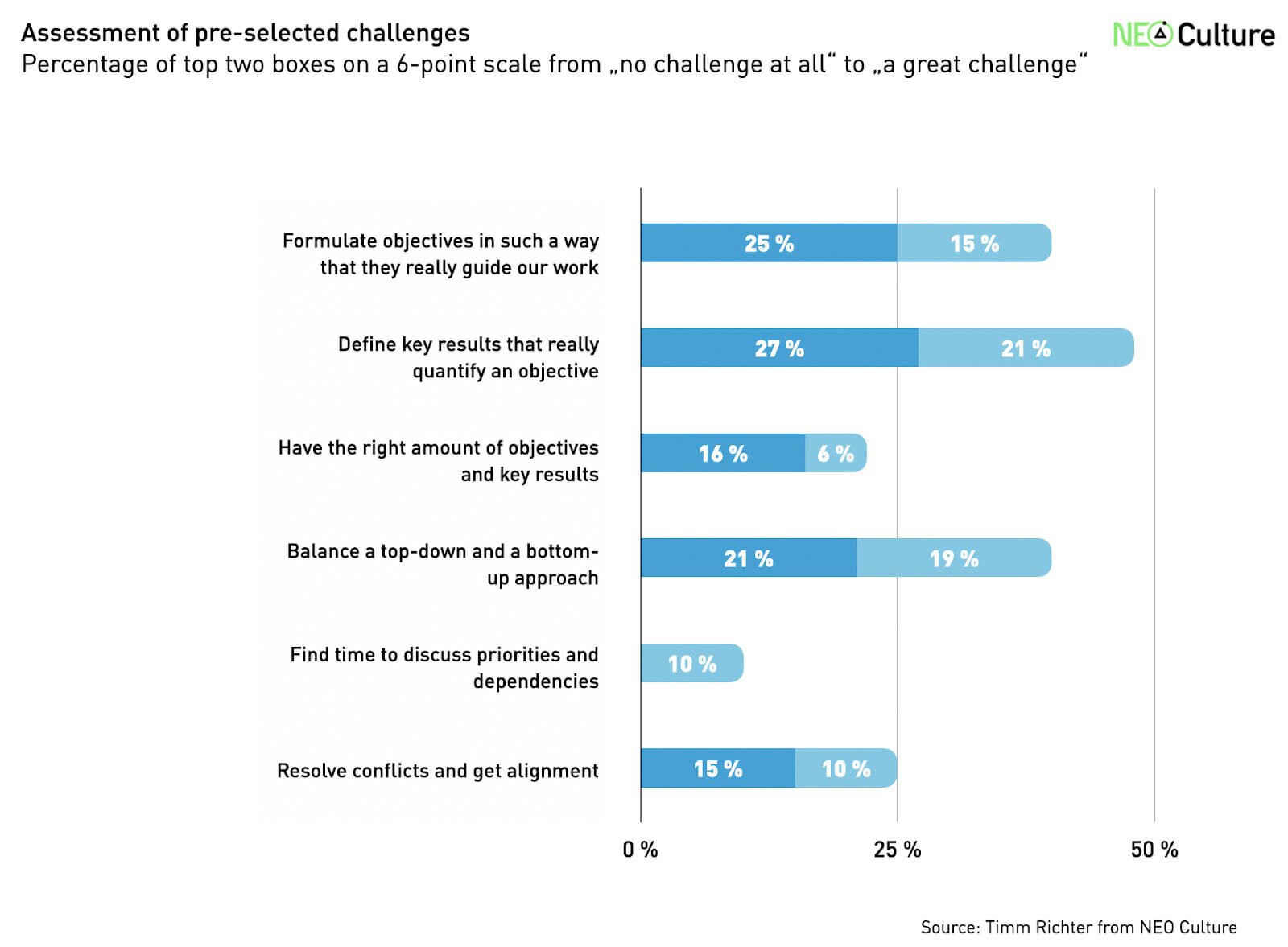
Almost half the participants (48%) find defining key results that really quantify an objective very challenging, with defining guiding objectives (40%), and balancing top-down and bottom-up (also 40%) coming joint second.
"What we see in the results is that impact reporters put more weight on the objectives and find them more difficult to formulate than the average participant," says Timm. "However, hierarchical issues such as balancing top-down/bottom-up, resolving conflicts, and getting alignment, are less challenging for this group."
Another observation is that the challenge of identifying the right objectives and key results seems to increase with the size of the company. Typically, participants from small companies find this less challenging than the average participant.
Some of the trade-offs made are not the ones needed for success
We showed participants 10 trade-offs and asked them to rate how their company currently handles each as well as how they believe those trade-offs should be handled in order to be successful – for the results see the table below.
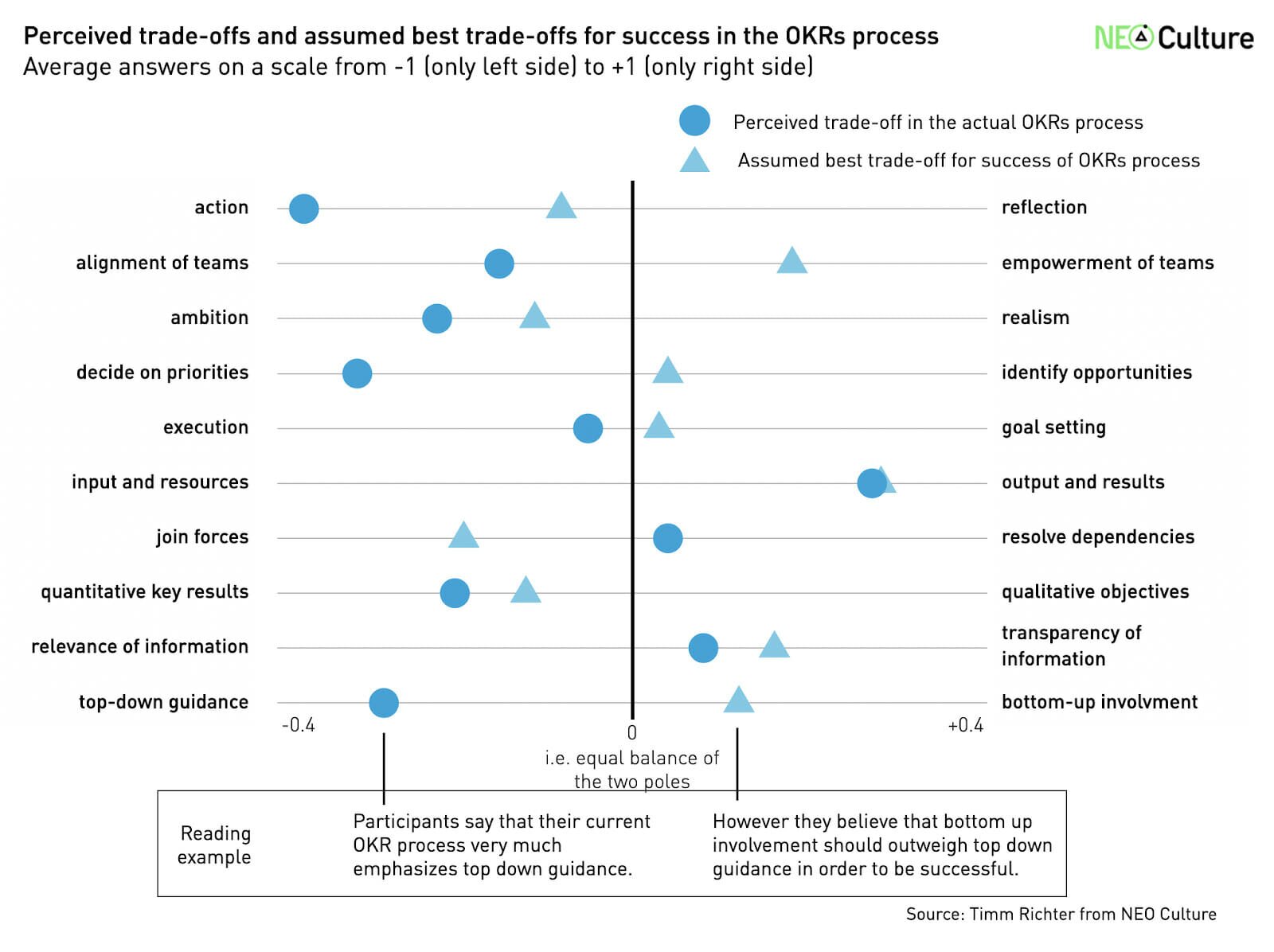
The ratings that participants give these trade-offs indicates that they experience OKRs as a more functional process, one to help them to get stuff done. For example, they chose:
- Action rather than reflection
- Deciding on priorities rather than identifying opportunities
- Top-down guidance rather than bottom-up involvement
- Output and results rather than input and resources
The participants believe that for OKRs to create success they should more strongly emphasise team involvement and identifying opportunities.
"By looking at the results of our different subgroups, we also learned from this part of the survey that the companies our impact reporters work at handle these trade-offs in a much more open way," says Timm. "They put more emphasis on transparency, on the empowerment of teams, and on identifying opportunities. They're also even more focused on output and results."
Our OKR veterans report more emphasis on identifying opportunities and the transparency of information, and both impact reporters and OKR veterans agree that action should be more balanced with reflection and that top-down guidance should be more balanced with bottom-up involvement.
Do OKRs improve performance? The jury's out
Fewer than 15% of participants feel that OKRs deliver substantial performance improvements and greater customer value – see the results of a 6-point-scale evaluation below.
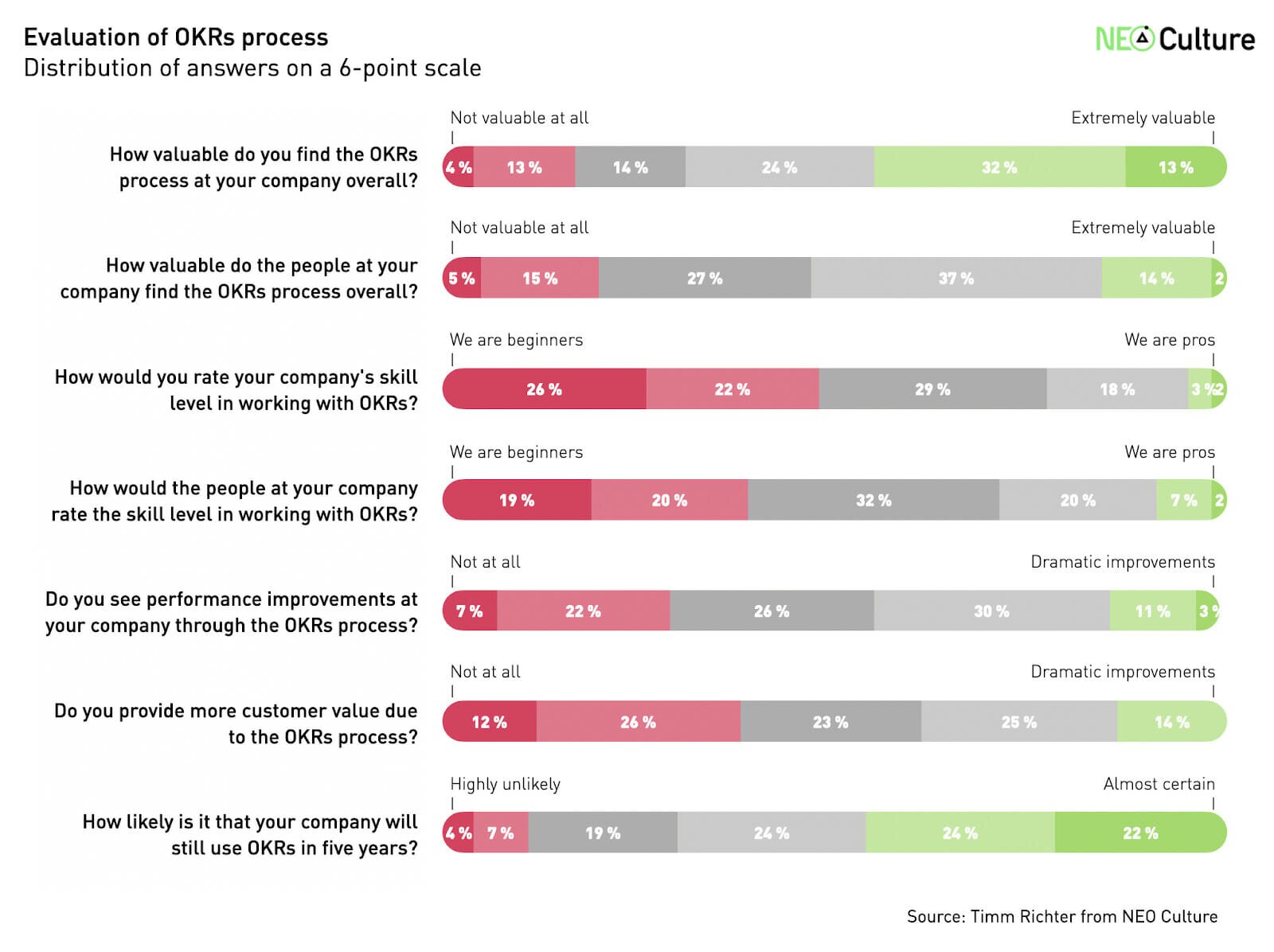
"While this result is somewhat sobering," says Timm, "it's important to keep in mind that when it comes to OKRs, it's still early days for most product teams we surveyed." In fact, 46% of participants say their companies have been using OKR for less than a year and another 32% for only 1-2 years.
"Perhaps the perception of the impact of OKRs will change over time and it's possible that participants believe it's simply too early to make a call on whether OKRs are valuable."
It's also possible that issues or uncertainty relate more to experience as 57% of participants consider their company’s OKR skill level to be relatively low. And this is an issue in and of itself as Marty Cagan at SVPG recently highlighted on the SVPG blog: "companies are not set up to effectively apply this technique" he said. For this reason, Marty has stopped recommending the practice: “in so many companies, even though conceptually the technique is simple and sound, it ends up proving a waste of time and effort, and yields little if any results.”
In her talk To OKR, Or Not To OKR, Flavia Neves, VP of Product at FreeNow, also points out that the positive impact of OKRs not only depends on applying the framework correctly. If OKRs are to work, organisations need to have the right mindset, leadership style, and clarity regarding roles, metrics, and other factors.
Despite this current uncertainty, almost half of our participants believe that their company will continue to use OKRs in the future.
“It is fascinating how long many organisations are ready to keep investing into making OKRs work despite very mixed and rather disappointing initial returns,” says Arne.
Top Takeaways and Tips
Time for a quick recap. Here are the top five learnings and some takeaway points and tips:
- OKRs are still new – 78% have been using OKRs for less than two years
- Focusing objectives is hard – 38% of teams have more than three
- The process is top-down – 69% say an OKR cycle starts with top management
- OKRs do aid transparency – In 68% of companies, everybody sees all OKRs and 48% see transparency as a key benefit
- OKRs don't equal performance leaps – only 15% think they do but almost half say it is very likely they'll continue to use them in the future
OKRs are a Shared Responsibility
The OKRs process is a continuous attempt to create more shared understanding and alignment. It is not a top-down versus bottom-up fight, but rather a shared responsibility.
Tip: Try to set clear role expectations around solving conflicts, allow teams to decide as much as possible, but let top management jump in when there's a risk of things grinding to a halt.
Shaping Objectives and Key Results Is Hard
Identifying qualitative objectives and quantitative key results is a challenging art that requires practice and experience. Objectives and key results present two different perspectives on setting goals and both perspectives are helpful but setting them can cause conflict – this isn't a bad thing, just be prepared for it.
Tip: Don’t over-engineer the process – keep it simple, focus on the big issues where you need alignment. When in doubt, put more emphasis on the objective than the key result as it gives teams space to come up with ideas you haven’t thought of. Keep in mind that less can really be more – even having one objective is ok.
A Relaxed and Open Approach Reaps Rewards
The participants who reported the most significant improvements as a result of OKRs were our impact reporters so we'd all do well to take note of what their results indicate.
Tip: Like our impact reporters, don't rush the process – take more time to set your OKRs, allow teams to handle conflict amongst themselves but be prepared to let top-management step in when necessary, and be open to trade-offs.
Join Us as We Dig Deeper Into the Results
During our Autumn edition of #mtpcon Digital November (18-19) we ran a panel dedicated to OKRs including an in-depth discussion on the results highlighted in this report. Our special guests included Timm Richter, MD of NEO Culture, Arne Kittler, VP Product at XING, Megan Murphy, VP of Product Management at Hotjar, and Flavia Neves, VP of Product at FreeNow. Watch the panel now:



